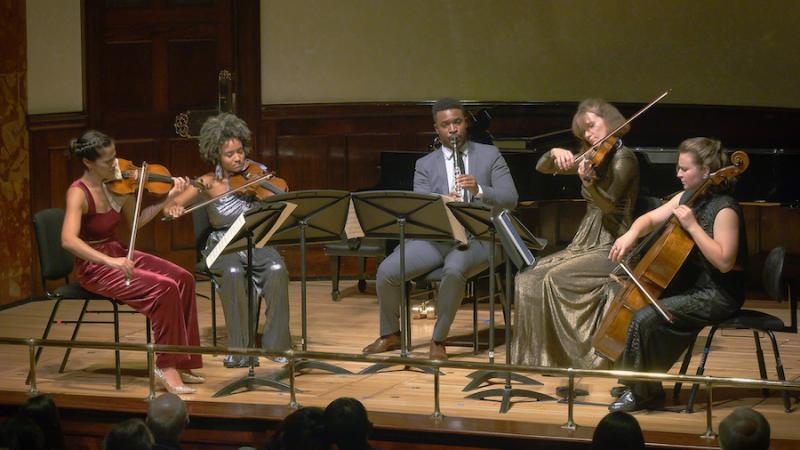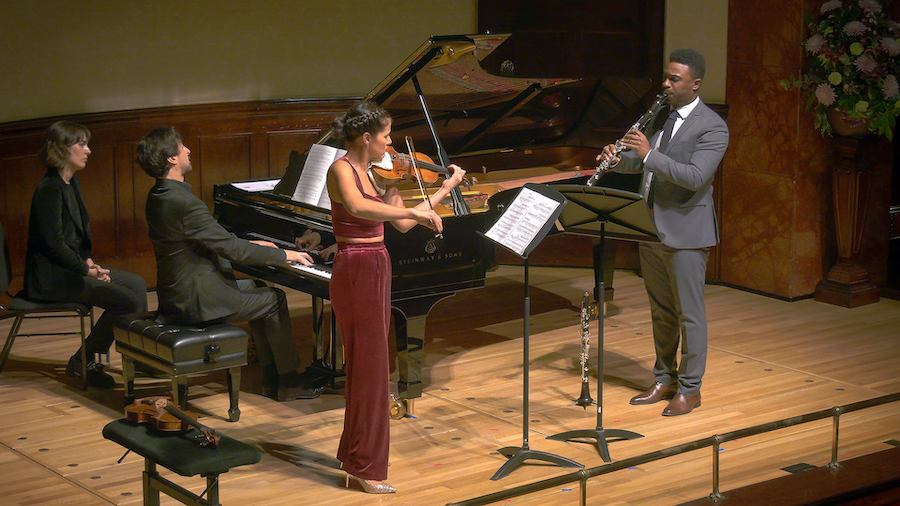Kaleidoscope Chamber Collective, Wigmore Hall review - warm and colourful Bartók and Brahms | reviews, news & interviews
Kaleidoscope Chamber Collective, Wigmore Hall review - warm and colourful Bartók and Brahms
Kaleidoscope Chamber Collective, Wigmore Hall review - warm and colourful Bartók and Brahms
Versatile chamber ensemble excels in clarinet-focused repertoire

Last Monday my colleague Boyd Tonkin was delighted by the Kaleidoscope Chamber Collective’s playing at Hatfield House – and on Thursday it was my turn to be impressed by their colourful Wigmore Hall recital, which featured the marvellous clarinettist Carlos Ferreira in Bartók and Brahms.
In Bartók’s Contrasts, Ferreira (pictured below) was following in the footsteps of Benny Goodman, who co-commissioned the piece in 1938. There are distinctively Goodmanesque moments in which Bartók channels the recently deceased George Gershwin, and Ferreira found a rich and resonant American accent for these bits. Elsewhere it was all about Bartók’s trademark mercurial switches of character and mood, outbursts on the clarinet, sardonic commentary from the piano (Tom Poster) a furious violin cadenza by Elena Urioste. By the final movement Gershwin is forgotten and it’s all about Hungary, Poster playing the part of a would-be cimbalom, the clarinet and violin whirling and jittering, the whole thing manic and wonderful. Dora Pejačević’s Piano Quartet in D minor from 1908 was also on the programme Boyd covered, and like him I found it very enjoyable, after a first few minutes when I feared it might just be some second-hand Brahms. But the slow movement, with its echoes of Elgar and the Edwardian parlour song, was magical and rapt. It is unashamedly sentimental, which vein the players indulged just enough, while still taking the music seriously: it made for captivating listening.
Dora Pejačević’s Piano Quartet in D minor from 1908 was also on the programme Boyd covered, and like him I found it very enjoyable, after a first few minutes when I feared it might just be some second-hand Brahms. But the slow movement, with its echoes of Elgar and the Edwardian parlour song, was magical and rapt. It is unashamedly sentimental, which vein the players indulged just enough, while still taking the music seriously: it made for captivating listening.
After the interval Carlos Ferreira was back for Brahms’s late Clarinet Quintet, a big-boned masterpiece, presented with humility and splendidly collegiate playing. Although the clarinet is at the heart of things – and Ferreira’s playing was fluent and warm – a lot of the pleasure was in the interplay of the lower parts, Laura van der Heijden’s perky cello lines interweaving with Rosalind Ventris’s viola and Melissa White’s violin. Elena Urioste’s solo in the second movement had almost religious overtones, but my favourite passage was the very end, where the younger Brahms would have had pounding double octaves and flying arpeggios, but the valetudinarian composer opted for a poised and hushed final moments, played here with the utmost stillness and restraint.
rating
Share this article
The future of Arts Journalism
You can stop theartsdesk.com closing!
We urgently need financing to survive. Our fundraising drive has thus far raised £49,000 but we need to reach £100,000 or we will be forced to close. Please contribute here: https://gofund.me/c3f6033d
And if you can forward this information to anyone who might assist, we’d be grateful.

Subscribe to theartsdesk.com
Thank you for continuing to read our work on theartsdesk.com. For unlimited access to every article in its entirety, including our archive of more than 15,000 pieces, we're asking for £5 per month or £40 per year. We feel it's a very good deal, and hope you do too.
To take a subscription now simply click here.
And if you're looking for that extra gift for a friend or family member, why not treat them to a theartsdesk.com gift subscription?
more Classical music
 Hallé John Adams festival, Bridgewater Hall / RNCM, Manchester review - standing ovations for today's music
From 1980 to 2025 with the West Coast’s pied piper and his eager following
Hallé John Adams festival, Bridgewater Hall / RNCM, Manchester review - standing ovations for today's music
From 1980 to 2025 with the West Coast’s pied piper and his eager following
 Kaploukhii, Greenwich Chamber Orchestra, Cutts, St James's Piccadilly review - promising young pianist
A robust and assertive Beethoven concerto suggests a player to follow
Kaploukhii, Greenwich Chamber Orchestra, Cutts, St James's Piccadilly review - promising young pianist
A robust and assertive Beethoven concerto suggests a player to follow
 Robin Holloway: Music's Odyssey review - lessons in composition
Broad and idiosyncratic survey of classical music is insightful but slightly indigestible
Robin Holloway: Music's Odyssey review - lessons in composition
Broad and idiosyncratic survey of classical music is insightful but slightly indigestible
 Classical CDs: Wolf-pelts, clowns and social realism
British ballet scores, 19th century cello works and contemporary piano etudes
Classical CDs: Wolf-pelts, clowns and social realism
British ballet scores, 19th century cello works and contemporary piano etudes
 Bizet in 150th anniversary year: rich and rare French offerings from Palazzetto Bru Zane
Specialists in French romantic music unveil a treasure trove both live and on disc
Bizet in 150th anniversary year: rich and rare French offerings from Palazzetto Bru Zane
Specialists in French romantic music unveil a treasure trove both live and on disc
 Scottish Chamber Orchestra, Ibragimova, Queen’s Hall, Edinburgh review - rarities, novelties and drumrolls
A pity the SCO didn't pick a better showcase for a shining guest artist
Scottish Chamber Orchestra, Ibragimova, Queen’s Hall, Edinburgh review - rarities, novelties and drumrolls
A pity the SCO didn't pick a better showcase for a shining guest artist
 Kilsby, Parkes, Sinfonia of London, Wilson, Barbican review - string things zing and sing in expert hands
British masterpieces for strings plus other-worldly tenor and horn - and a muscular rarity
Kilsby, Parkes, Sinfonia of London, Wilson, Barbican review - string things zing and sing in expert hands
British masterpieces for strings plus other-worldly tenor and horn - and a muscular rarity
 From Historical to Hip-Hop, Classically Black Music Festival, Kings Place review - a cluster of impressive stars for the future
From quasi-Mozartian elegance to the gritty humour of a kitchen inspection
From Historical to Hip-Hop, Classically Black Music Festival, Kings Place review - a cluster of impressive stars for the future
From quasi-Mozartian elegance to the gritty humour of a kitchen inspection
 Shibe, LSO, Adès, Barbican review - gaudy and glorious new music alongside serene Sibelius
Adès’s passion makes persuasive case for the music he loves, both new and old
Shibe, LSO, Adès, Barbican review - gaudy and glorious new music alongside serene Sibelius
Adès’s passion makes persuasive case for the music he loves, both new and old
 Anja Mittermüller, Richard Fu, Wigmore Hall review - a glorious hall debut
The Austrian mezzo shines - at the age of 22
Anja Mittermüller, Richard Fu, Wigmore Hall review - a glorious hall debut
The Austrian mezzo shines - at the age of 22
 First Person: clarinettist Oliver Pashley on the new horizons of The Hermes Experiment's latest album
Compositions by members of this unusual quartet feature for the first time
First Person: clarinettist Oliver Pashley on the new horizons of The Hermes Experiment's latest album
Compositions by members of this unusual quartet feature for the first time

Add comment